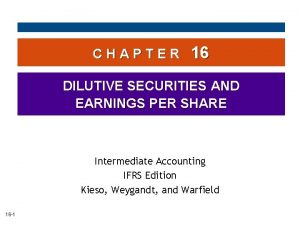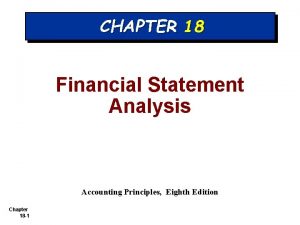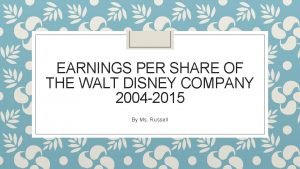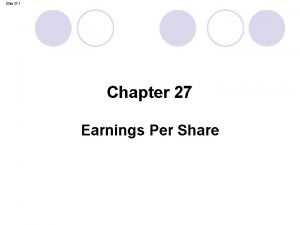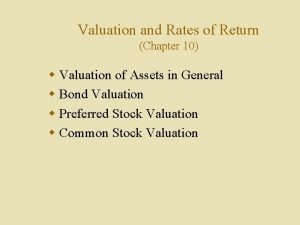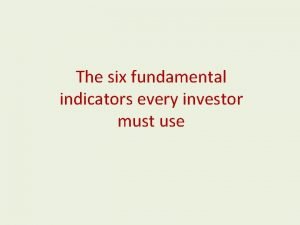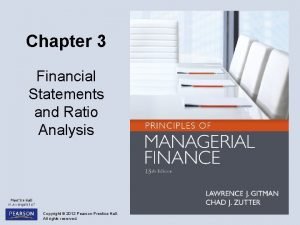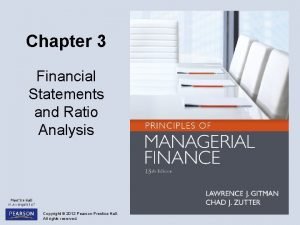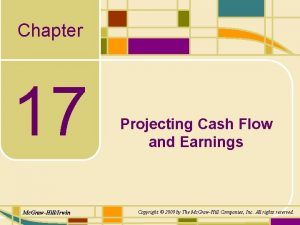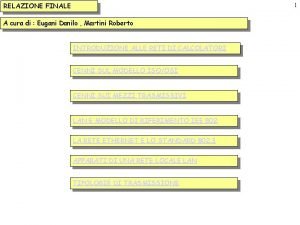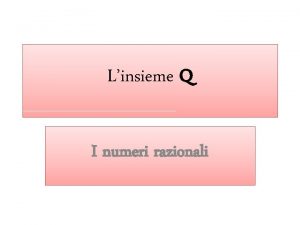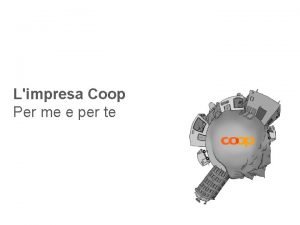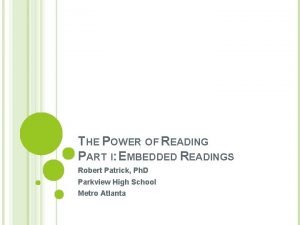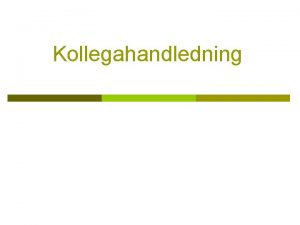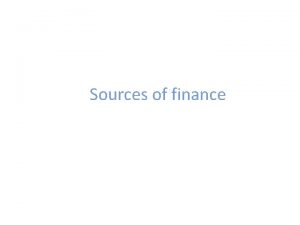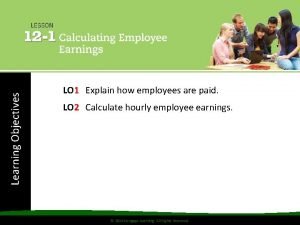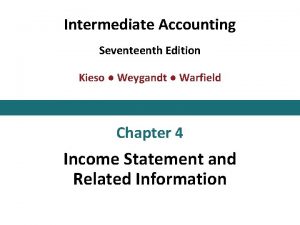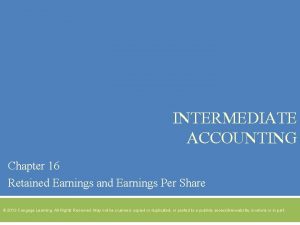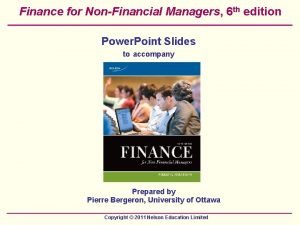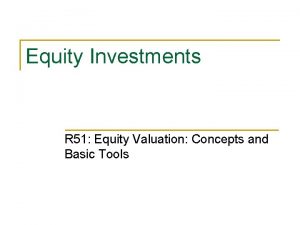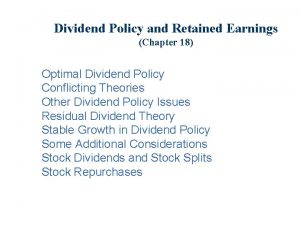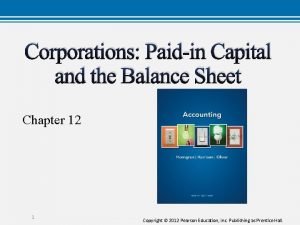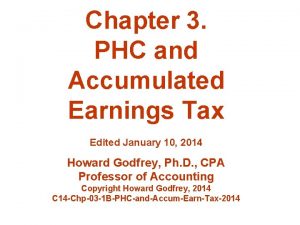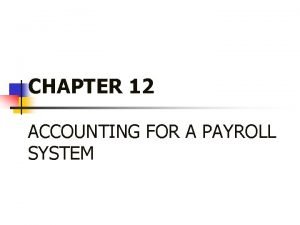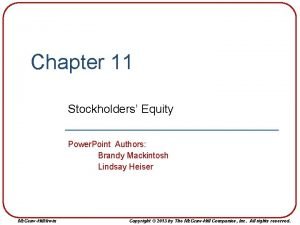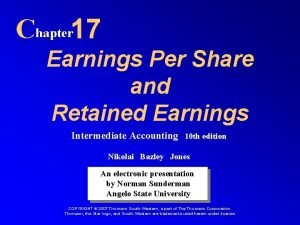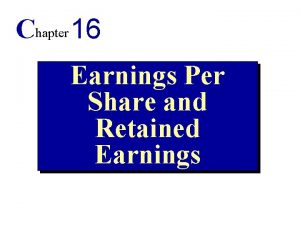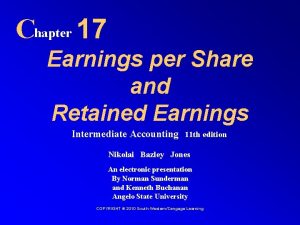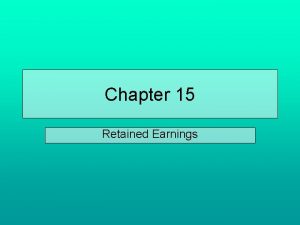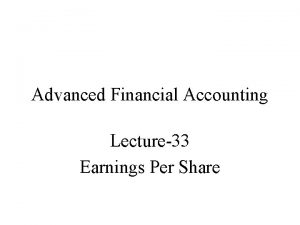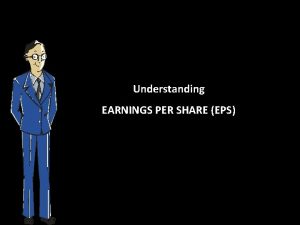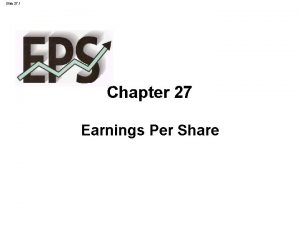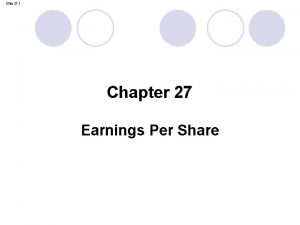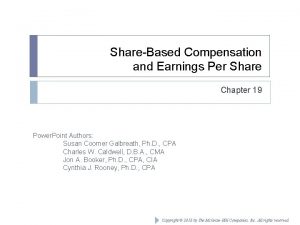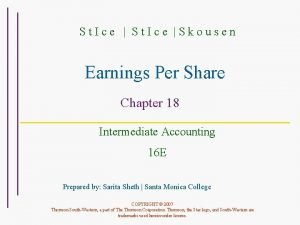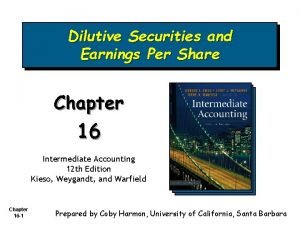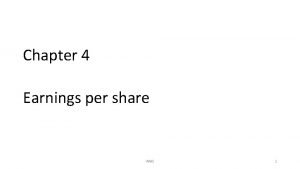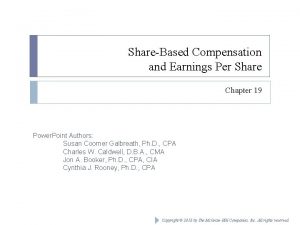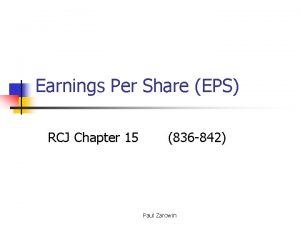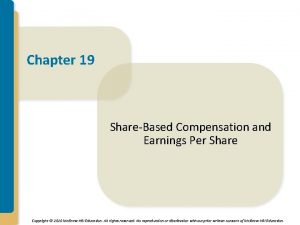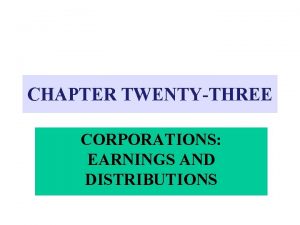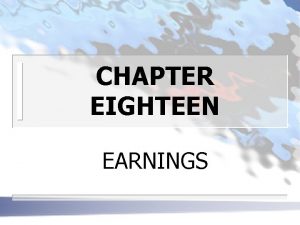Slide 27 1 Chapter 27 Earnings Per Share







































- Slides: 39

Slide 27. 1 Chapter 27 Earnings Per Share 1

Slide 27. 2 By the end of the chapter, you should be able to: • define earnings per share and the PE ratio; • comment critically on the PE ratio of an enterprise in comparison with the industry average; • calculate the basic and diluted earnings per share. 2

Slide 27. 3 INVESTOR RATIOS The market price and performance of a company’s shares indicate what investors think of a company. Market price: the price people are willing to buy and sell the shares of a company for. Includes information about how investors see the potential risk and return connected with owning a part of the company. Companies are diverse: they have different numbers of issued shares, differing levels of profits and dividends, differing activities/industries and differing future prospects. 3

Slide 27. 4 INVESTOR RATIOS To get the necessary information to enable an investment decision to be made, the following ratios need to be considered: earnings per share price/earnings ratio dividend per share dividend yield dividend cover net tangible asset backing per share. 4

Slide 27. 5 INVESTOR RATIOS Earnings per share (EPS) EPS is the amount of net profit per share of the company’s ordinary shares. The formula is The net profit available for paying dividends to the ordinary shareholders is used. Preference dividends and taxes are deducted because the preference shareholders and the Tax Department have prior claims on the profit. 5

Slide 27. 6 INVESTOR RATIOS Price/earnings (P/E) ratio Measures the ratio of the current market price of the ordinary shares to the EPS of the ordinary shares. Useful for comparing different companies. Tells how many years the investor is prepared to wait to recover the price of the shares at the current rate of return If a company’s P/E ratio is higher than that of other companies, investors expect its profits (and dividends and share price) to grow more quickly than those of the other companies. 6

Slide 27. 7 INVESTOR RATIOS Dividends per share (DPS) Shows how much of the net profit is paid to shareholders for each ordinary share they hold. Normally, DPS will be less than EPS because companies prefer to retain part of the net profit to help fund future expansion. The formula is: 7

Slide 27. 8 INVESTOR RATIOS Dividend yield The ratio of DPS to the share’s market price. It measures the percentage of the share’s value that is returned each year as dividends to the shareholder. Preference shareholders, whose main reason for investing is to receive dividends, pay special attention to this ratio. The formula is: 8

Slide 27. 9 INVESTOR RATIOS Dividend cover Shows how many times the net profit after tax and preference dividends covers the dividend payout to ordinary shareholders. The ratio is calculated as follows: 9

Slide 27. 10 INVESTOR RATIOS Net tangible asset backing per share (NTA) Also called the book value per share. Shows how much the shareholder can expect to get back should the company cease operations. It assumes that the value of the assets shown in the Balance Sheet is a fair indication of the price that would be obtained if they were sold. The formula is: 10

Slide 27. 11 WHY EPS IS IMPORTANT Component of PE ratio Here is a typical press extract. EPS* 35. 95 8. 65 57. 40 * Not part of the press release, but useful information 11

Slide 27. 12 FACTORS THAT AFFECT THE PE RATIO Investors’ confidence – external influences International scene National economy Industry sector. 12

Slide 27. 13 FACTORS THAT AFFECT THE PE RATIO (CONTINUED) Investors’ confidence – external influences Current year’s performance Potential changes and possible future implication Management change replacing failing recruiting successful High growth prospects – high PE ratio Poor growth prospects – high PE if takeover likely. 13

Slide 27. 14 INVESTOR RATIOS Earnings per share (EPS) EPS is the amount of net profit per share of the company’s ordinary shares. The formula is Or, Basic EPS = earnings/weighted number of ordinary shares The net profit available for paying dividends to the ordinary shareholders is used. Preference dividends and taxes are deducted because the preference shareholders and the Inland Revenue Department have prior claims on the profit. 14

Slide 27. 15 EARNINGS PER SHARE – BASIC CALCULATION Basic EPS = earnings/weighted number of ordinary shares 15

Slide 27. 16 Earnings per share – diluted calculation 16

Slide 27. 17 INVESTOR RATIOS Calculating the number of shares on issue can be difficult to determine – why? Effect of convertible securities on issue, share options on issue, warrants on issue, and accounting polices Why do these create a problem? Must allow for the likely number of shares that will be taken up by holders of these securities at the option date. Accounting policies can affect the calculation of EPS because of the effect a change in accounting policies can have on the net profit figure. 17

Slide 27. 18 LIMITATIONS OF EPS AS PERFORMANCE MEASURE Based on historical earnings No account of inflation Real growth differing from apparent growth Inter-company comparison adversely affected Management choice over accounting policies Changes in capital structure. 18

Slide 27. 19 BEPS CALCULATION Watts plc share capital 1 m 50 p ordinary shares 1 m £ 1 10% preference shares Watts post tax profit for 20 X 1 £ 1, 250, 000. 19

Slide 27. 20 BEPS CALCULATION – BONUS ISSUE Assume post-tax profit in 20 X 0 and 20 X 1 £ 1, 250, 000 Assume bonus issue increased number of shares from 1 m 50 p to 2 m 50 p In 20 X 1 BEPS halved from £ 1. 15 to £ 0. 575 20 X 0 BEPS restated from £ 1. 15 to £ 0. 575. 20

Slide 27. 21 BEPS CALCULATION – SHARE SPLITS Treated Affects Aim same way as a bonus issue both current and previous year is to avoid appearance of a fall compared to previous year. 21

Slide 27. 22 BEPS CALCULATION – NEW ISSUE Now assume Company issues 500, 000 new shares on 30 September 20 X 1. Company does not have use for new capital for full year Misleading to use the closing number of shares Weight the number on a time-held basis. No. of shares £ 22

Slide 27. 23 BEPS CALCULATION – BUYBACK AT MARKET VALUE Aim is to include the number of shares on a time-held basis Weigh from beginning of year until date of buyback. Assume Watts bought back 240, 000 on 31. 5. 20 X 1. £ £ 23

Slide 27. 24 BEPS – RIGHTS ISSUE Four-step approach. 24

Slide 27. 25 RIGHTS ISSUE CALCULATION Assume 50 p ordinary shares had £ 4 market value Assume company offered a rights issue of One 50 p share @ £ 3. 25 For every two 50 p shares held. £ £ 25

Slide 27. 26 RIGHTS ISSUE CALCULATION (CONTINUED) Bonus element. £ 2 shares at fair value of £ 4 each prior to rights issue 1 share at discounted rights issue price of £ 3. 25 each 3 shares at fair value after issue (i. e. ex-rights) The theoretical ex-rights price is 11. 25/3 shares The bonus element is fair value 4 less 3. 75 26

Slide 27. 27 RIGHTS ISSUE CALCULATION (CONTINUED) Time apportion number of shares if issued part way through the year If 500, 000 shares issued after 3 months then weighted number is 125, 000. 27

Slide 27. 28 RIGHTS ISSUE CALCULATION (CONTINUED) Further adjustment to recognise bonus element. £ £ 28

Slide 27. 29 RIGHTS ISSUE CALCULATION (CONTINUED) Adjusted number of shares for current year. No. of shares 29

Slide 27. 30 RIGHTS ISSUE CALCULATION (CONTINUED) Adjust previous year for bonus element. £ £ 30

Slide 27. 31 DILUTED EPS Dilution may arise from: Convertible bonds Convertible preference shares Share options Share warrants. STOP HERE! 31

Slide 27. 32 DILUTED EPS – SHARE OPTIONS £ A P A S £ £ £ 32

Slide 27. 33 DILUTED EPS – CONVERTIBLE BONDS A A I A 33

Slide 27. 34 DILUTED EPS – CONVERTIBLE PREFERENCE SHARES Assume that Watts had at 31. 12. 20 X 1. £ A P C £ £ C 34

Slide 27. 35 DILUTED EPS – CONVERTIBLE PREFERENCE SHARES (CONTINUED) £ £ £ 35

Slide 27. 36 DILUTED EPS – SEVERAL POTENTIAL DILUTIONS Assume that Watts had at 31. 12. 20 X 1. £ A P £ £ A S £ C C £ £ £ 36

Slide 27. 37 DILUTED EPS – SEVERAL POTENTIAL DILUTIONS (CONTINUED) Increase in earnings Increase in number Earnings per of ordinary shares incremental share 37

Slide 27. 38 DILUTED EPS – SEVERAL POTENTIAL DILUTIONS (CONTINUED) Step 2: Determine the potential ordinary shares to include in the computation of diluted earnings per share Net profit attributable to continuing operations Ordinary shares Per share 38

Slide 27. 39 References Elliott, Barry, Elliott Jamie, Financial Accounting and Reporting 15 th Edition chapter 27 39
 Basic and diluted eps
Basic and diluted eps Basic earnings per share
Basic earnings per share Earnings per share ratio analysis
Earnings per share ratio analysis Creditor days
Creditor days Disney earnings per share
Disney earnings per share What is dividend per share
What is dividend per share What are the basic dance steps in heel and toe polka
What are the basic dance steps in heel and toe polka Preferred stock formula
Preferred stock formula Fundamental indicators
Fundamental indicators Intermediate accounting chapter 15
Intermediate accounting chapter 15 Book value per share formula
Book value per share formula Debt ratio analysis
Debt ratio analysis Cash flow per share
Cash flow per share How to slide and divide factoring
How to slide and divide factoring Slide per powerpoint
Slide per powerpoint Slide per powerpoint
Slide per powerpoint Approssimazione per difetto e per eccesso
Approssimazione per difetto e per eccesso Coop per me e per te
Coop per me e per te Mio diletto
Mio diletto Ka tik pamato pats tuo pavirsta
Ka tik pamato pats tuo pavirsta 27 miles per gallon into kilometers per liter
27 miles per gallon into kilometers per liter 60 minutes in 1 hour
60 minutes in 1 hour 1.800 dam/jam = hm/menit
1.800 dam/jam = hm/menit Per stirpes v per capita
Per stirpes v per capita Multas per gentes et multa per aequora vectus
Multas per gentes et multa per aequora vectus Longum iter est per praecepta breve per exempla
Longum iter est per praecepta breve per exempla Per capita vs per stirpes
Per capita vs per stirpes Catullus 84 translation
Catullus 84 translation Debentures advantages and disadvantages
Debentures advantages and disadvantages Justified forward p/e
Justified forward p/e How does threegreen calculate overtime earnings?
How does threegreen calculate overtime earnings? Intermediate accounting
Intermediate accounting Intermediate accounting chapter 16
Intermediate accounting chapter 16 Retained earnings ifrs
Retained earnings ifrs Ev/ebitda ratio
Ev/ebitda ratio Retained earnings in accounting
Retained earnings in accounting Return on common stockholders' equity
Return on common stockholders' equity Accumulated earnings credit
Accumulated earnings credit 12-1 calculating gross earnings
12-1 calculating gross earnings Par stock
Par stock
